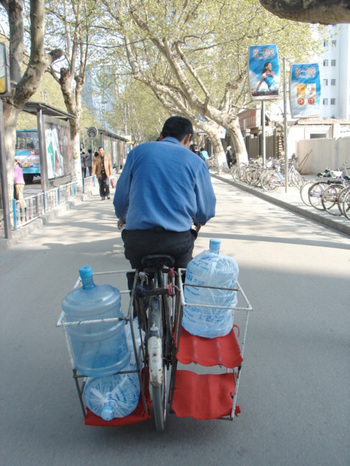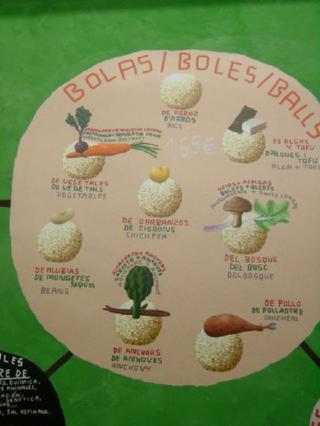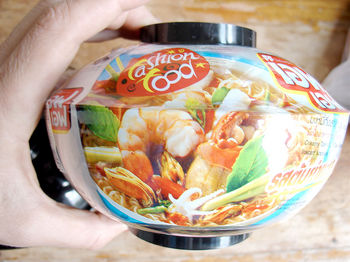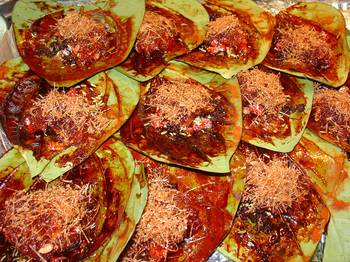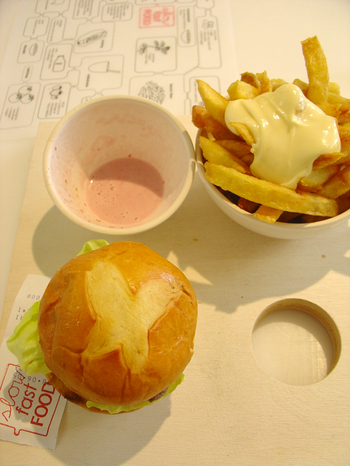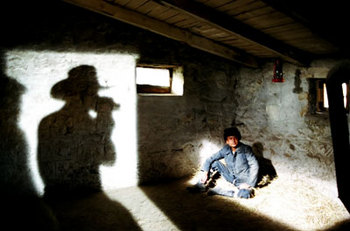Will swap saliva for a home, the problem with bird nest soup
April 4, 2006
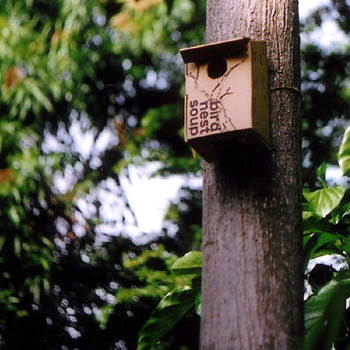
image from Hoko Studio design collaborative, cropped and used entirely without permission
If you were a bird living in a cave in Thailand, would you rather
1. live in a house of your own making constructed from spit and twigs?
or
2. live in a gifted house made out of recycled cardboard?
Bad question. Here comes a better one.
If your house was under threat of confiscation, would you rather
1. be given a house built out of recycled cardboard?
or
2. be left to your own devices to emotionalise enough angry bile and spit to produce a new casa de saliva?
It may be yesterday’s news to some, but I was surprised to read that swiftlets are suffering forced eviction due to gourmand greed! Swiftlets are the little birds whose nests are prized for bird nest soup. Some varieties of Thai swiftlet construct nests comprised of 80% lugie! Homelessness seems like a poor reward for resourcefullness.
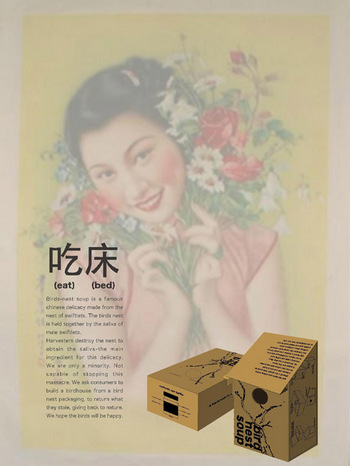
image from Hoko Studio design collaborative, cropped and used entirely without permission
Design collaborative Hoko Studio has a partial solution. And by ‘partial’, I mean partial. Use birdhouses to package and distribute the nests. When the cook is done leaching the saliva out of the nest, the customer can hang the packaging on a tree (or high up in a cave in Thailand) and commence slurping with a partially clean conscience!
Partial solutions are only half the beauty of critical design.
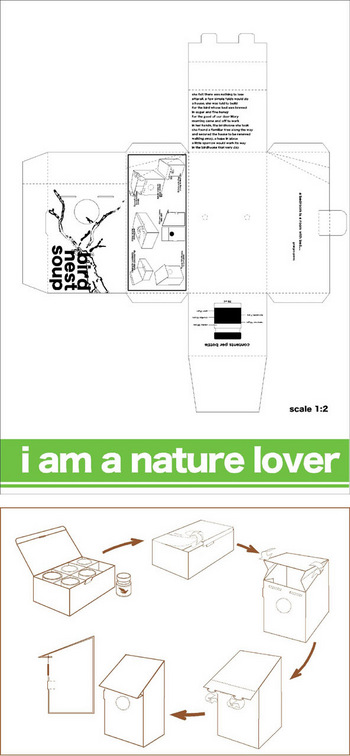
image from Hoko Studio design collaborative, cropped and used entirely without permission
- Know your bird nest
- Know your birds’ nests even more
- Hoko Studio’s ‘Eat Bed’ bird nest proposal at Platform 21
- Meet Hoko Studio Design Collaborative, the designers of ‘Eat Bed’
- Wikipedia bird’s nest soup page with a cool picture of a saliva nest
Hoko Studio’s proposal titled ‘Eat Bed’ is one of several ‘critical design’ projects exhibited at the Platform 21 website under the title, Positive Alarm (fixing what is wrong without making it wronger). Platform 21 is a newish venue for design situated in Amsterdam’s newish city center, de Zuidas, (pronounced South Central).
Here’s the Platform 21 culture blurb: ‘the domain of creation is not something professionals have a monopoly on. We are interested in creative developments in fashion and design, including amateur initiatives.’
Huh. Platform 21 does seem like an OK initiative, although their website is probably the most annoying surf you’ll have this week. Indeed a platform for Dutch and international design initiatives has been sorely missing ever since the nest known as the Vormgevings Instituut (pronounced Netherlands Design Institute) was confiscated by barbaric xenophobes back in the ’90’s. Maybe Platform 21 will provide a new place for design to alight. The director is ethnic Dutch, always a good starting point. Soup is on!
- Hoko Studio’s ‘Eat Bed’
- Platform 21 a design nest in Amsterdam’s Zuidas
- Platform 21’s online exhibition Positive Alarm
debra at 20:58 | Comments (0) | post to del.icio.us
37 uses for a dead sheep, a film review and a re-count
April 1, 2006

image used courtesy of Ben Hopkins and Tiger Lily Films, © Nikki Parrott
One of my favourite films at this year’s Berlinale (Forum), was Ben Hopkins magnificent meta-documentary, 37 Uses for a Dead Sheep. As far as I’m concerned, you really can’t go wrong with a film about yurts, yoghurt, nomadic tribes and the shifting borders of the ‘Stans’ in Central Asia. I put my pants on one leg at a time.
37 Uses, is not so much Hopkins’ film but a collaborative work, made with the Pamir Kirghiz tribe, a splendid historical document. The film begins in the 19th c. with the Super Powers divying up Central Asia, a region that since the inventions of salt, silk, and opium remains one of the hottest properties on earth. We watch as beautiful nostalgic footage is fabricated through the tribe’s reenactment, aided by the expert Kirghiz art direction of Muhammet Ekber Kutlu, son of the last Kirghizian khan, Rahman Qul.
In case you weren’t paying attention during Central Asian History, the Pamir Mountains are the North Westernmost range of the Greater Himalaya, but are the feather in the cap of what is now known as ‘the Stans’. Pakistan, Afghanistan, Turkmenistan, Uzbekistan, Tadjikistan, Kirghizstan and Kazachstan. Did I forget anyone? It’s all about where you think the centre of the world is situated, and that is what has been keeping the Kirghizians on the move, beyond their normal pasturalisations. The Pamir Kirghiz, no strangers to hardship inflicted by Super Powers, have (partially) avoided ethnic cleansing by doing what they do best, being nomadic.
Nomadic pastoralists have a greater need for pastures than borders, but when in 1979 the sheep trade with Kabul became impossible, Khan Rahman Qul moved his entire tribe all the way down to Gilgit in Pakistan. There he tried to find a suitable homeland for his people, at one point applying for 1000 visas to move the entire kit and kaboodle to Alaska!
Since 1982, the Pamir Kirghiz live in Ullapamir. Pamir yes, Kirghizstan, no. Ullapamir is in Eastern Turkey, where the Kirghiz live in cement houses, not yak felt yurts, sedentary, no longer nomadic. People born after 1982 have no knowledge of the traditional Kirghiz lifestyle, and Hopkins’ film ends with the story of a very urban young Kirghizian nurse living in Istanbul. When you see this educated woman, you can’t imagine her, or even wish upon her, the task of milking a yak or a sheep, and seeing to the fermentation of dairy products. Although…
37 Uses for a Dead Sheep is larded with Hopkins trying to get his head around what seems to be an endless amount of things that you can do with Kirghzian livestock. These were for me the funniest scenes, and not just because they were talking a lot about yoghurt. The only disappointing thing about this wonderful film is that there aren’t really 37 uses for a dead sheep, but only 36. And while I’ll be the first to admit that dung is useful, the old man counted it twice. Bring down the total to 35!
Yoghurt features prominently in the history of the Pamir Kirghiz tribe. There is a hilariously acted scene in which the young Rahman Qul is saved from Russian poison by tucking into a bowl of yoghurt. Because 7 of the 35 uses of a dead sheep are yoghurt-related, I would like to remind Hopkins that you don’t actually need to kill a sheep to extract its precious yoghurt. But I cede that the film’s title wouldn’t have the same ring to it.
37 Uses for a Dead Sheep is an excellent film about people making history, making film, and a little bit about making yoghurt.
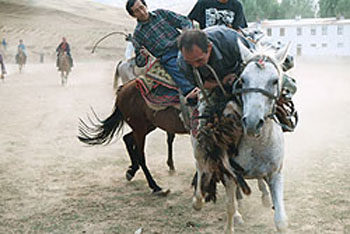
- 37 Uses for a Dead Sheep’s Production Company, Tiger Lily Films
- Sales Agent, Electric Sky
- Nazif Shahrani, scholar, filmmaker of the ’splendid historical document’, the ethnographic film, the Kirghiz of Afghanistan
- Excellent abbreviated history of the Pamir Kirghiz people by Iraj Bashiri!
- Location, location, location! Here’s a map of the Stans
- Yurt porn galore and a smidgeon of academic orientalism at Turkotek
- The Red Book of the Peoples of the Russian Empire
- Ethnology and language resource for Central Asia
- Pamir, the roof of the world
-
Understanding the Geographies of China
An assemblage of pieces by Robert McColl - Kirghizstan, the real deal
debra at 18:10 | Comments (0) | post to del.icio.us
A definitive list? 37 Uses for a Dead Sheep
According to the Pamir Kirghiz tribe, this is a list of the 37 (pronounced 35, and possibly 34) things you can do with a (dead) sheep:
1. ayran (yoghurt)
2. qurut (boiled ayran)
3. kurtap (sun dried qurut)
4. susme (thickened ayran mixed with qurut)
5. ajigey (cream heated to thicken)
6. kaymac (cream)
7. byshteq (pressed and cut qurtap?)
8. charity
9. wool
10. milk
11. dung
12. karen (?)
13. meshgeh (?)
14. sari mai (?)
15. nakhtan mai (?)
16. meat
17. leather
18. clothes
19. bedding
20. as money
21. tumaq (hat)
22. takta pos (?)
23. akui (yurt!)
24. kop (?)
25. kurchun (?)
26. kalkma (?)
27. palas (?)
28. bol (?)
29. arkan (?)
30. dung AGAIN!
31. amanat (charity of lent livestock - isn’t that the same as # 8?)
32. toi (birth son sacrifice?)
33. wedding
34. kurban eid (?)
35. when the bride comes (?)
36. military service (?)
debra at 11:40 | Comments (1) | post to del.icio.us

